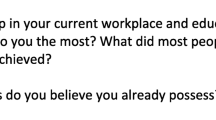Abstract
This paper examines whether leadership as a research area is becoming an autonomous field. Our main argument is that leadership is emerging as one of the fastest growing academic fields in higher education, demonstrating considerable increases in the number of publications and citations in the field. This growth is not affected by the low percent of funding in this research area. The surge in the number of authors and scholarly contributions ensures the continued development of this field. Furthermore, leadership is becoming institutionalized as a field of study in academia. In light of these findings, we argue that there are positive indications that leadership will become an autonomous research field in the near future.


Similar content being viewed by others
Further Reading
Andersen, J.A. (2016). An old man and the “sea of leadership”. Journal of leadership studies, 9 (4), 70–81.
Antonakis, J. Bastardoz N., Liu, Y., Schriesheim, A.C. (2014). What makes articles highly cited? The Leadership Quarterly 25 (2014) 152–179.
Bass, B. (1990) Bass and Stogdill’s Handbook of Leadership: a Survey of Theory and Research. New York: Free Press.
Borgman, C.L. (1990). Editor’s preface In: Scholarly communication and bibliometrics (Borgman Ed.),London: Sage publications.
Bryman A. (1992) Charisma and Leadership in Organizations. London: Sage.
Bush, T. (2019). Distinguishing between educational leadership and management: Compatible or incompatible constructs? Educational Management Administration and Leadership, 47, (4), 501–503.
Clarivate Analytics World of Science database (2020).
Dansereau, F., Graen, G., & Haga, W. (1975a) “A vertical dyad linkage approach to leadership in formal organizations”, Organizational Behavior and Human Performance, 13: 46–78.
Dansereau, F., Graen, G., & Haga, W. (1975b) “Leader-member exchange and improvement: direct and interactive effects on job satisfaction, turnover intentions, and performance”, Leadership Quarterly, 20, 371–382.
Day, D., & Antonakis, J. (2012) “Leadership: Past, Present and Future”. In Day D. & Antonakis J. (Eds.) The Nature of Leadership,pp. 3–29. Thousand Oaks: Sage.
Day, D. V. (2020). The Leadership Quarterly Yearly Review: Comprehensive and integrative perspectives on leadership research, theory, and methods. The Leadership Quarterly, 31, (1), 101, 402.
Denis, J., Langley, A., & Sergi, A. (2012), “Leadership in the Plural”, The Academy of Management Annals, Vol.6 No.1, pp.211–283.
Fiedler, F. E. (1964) “A Contingency Model of Leadership effectiveness”, Advanced Experimental Social Psychology, 1: 149–190.
Fiedler, F. E. (1967) A Theory of Leadership Effectiveness. New York: McGraw Hill
Glänzel, W., & Thijs, B. (2012). Using ‘core documents’ for detecting and labelling new emerging topics. Scientometrics, 91(2), 399–416
Gordon, A. (2007). Transient and continuant authors in a research field: The case of terrorism. Scientometrics, 72, (2), 213–224.
Guide to College Majors in Leadership (n.d.).(2020) What is Leadership and Organizational Management?http://www.worldwidelearn.com/online-education-guide/business/leadership-major.htm
Jones, S., Hadgraft, R., Harvey, M., Lefoe, G. & Ryland, K. (2014). Evidence-based Benchmarking Framework for a Distributed Leadership Approach to Capacity Building in Learning and Teaching. Sydney, Australia: Office for Learning and Teaching, Department of Education.
Katz, D. et al.(1951) Productivity, Supervision and Morale among Railroad Workers. Oxford: Survey Research Center.
Mann, R. (1959) “A review of the relationships between personality and performance in small groups”, Psychoanalytic Bulletin, 56: 241–270.
Meadows, A.J. (1998). Communicating science. San Diego:Academic Press
Northouse, P. (2010) Leadership. Los Angeles: Sage.
Sachi, K. (2017) Why research papers should not be anonymous? Current science 112 (3), 451–451.
Stogdill, R. (1948)” Personal factors associated with leadership: a survey of the literature”, Journal of Psychology, 25: 35-71.
Stogdill R., Coons A. (ed). (1957) Leader behavior: Its Description and Measurement. Oxford: Ohio State University.
Tal, D., & Avishag, G. (2016). “Leadership of the present, current theories of multiple involvements: a bibliometric analysis”, Scientometrics, 107(1), 259–269.
Tintore M. (2019). Introducing a model of transformational prosocial model. Journal of leadership studies, 13, (3), 15-34.
Author information
Authors and Affiliations
Corresponding author
Additional information
Publisher’s Note
Springer Nature remains neutral with regard to jurisdictional claims in published maps and institutional affiliations.
Rights and permissions
About this article
Cite this article
Tal, D., Gordon, A. Leadership as an Autonomous Research Field: A Bibliometric Analysis. Soc 57, 489–495 (2020). https://doi.org/10.1007/s12115-020-00522-2
Published:
Issue Date:
DOI: https://doi.org/10.1007/s12115-020-00522-2




